
A long-range reconnaissance patrol, or LRRP, is a small, well-armed reconnaissance team that patrols deep in enemy-held territory.

In military organizations, a pathfinder is a specialized soldier inserted or dropped into place in order to set up and operate drop zones, pickup zones, and helicopter landing sites for airborne operations, air resupply operations, or other air operations in support of the ground unit commander. Pathfinders first appeared in World War II, and continue to serve an important role in today's modern armed forces, providing commanders with the option of flexibly employing air assets. There was a group of pilots who were also designated pathfinders. They flew C-47 (DC-3) aircraft and were the lead planes followed by paratroop transports, used for dropping paratroopers into designate drop zones such as on D day, the Normandy Invasion.
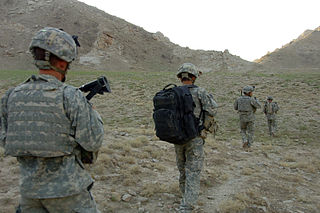
Long-range surveillance (LRS) teams were elite, specially-trained surveillance units of the United States Army employed for clandestine operation by Military Intelligence for gathering direct human intelligence information deep within enemy territory. Classic LRS employment is to infiltrate deep into enemy territory, construct hide and surveillance sites, and provide continuous surveillance/special reconnaissance of an intelligence target of key interest.
Reconnaissance, surveillance, and target acquisition (RSTA) groups the tasks of reconnaissance, surveillance and target acquisition conducted by the Department of Defense. RSTA supports military operations at a strategic, operational, or tactical level, either by dedicated RSTA forces or those which possess the capability.

United States Army Reconnaissance and Surveillance Leaders Course (RSLC) is a 29-day school designed on mastering reconnaissance fundamentals of officers and non-commissioned officers eligible for assignments to those units whose primary mission is to conduct reconnaissance and surveillance, target acquisition, and combat assessment operations. RSLC is taught by the 4th Ranger Training Battalion, Airborne and Ranger Training Brigade. The school is open to Soldiers, Marines, Sailors and Airmen to train them to expert levels in reconnaissance, surveillance, target acquisition, battle damage assessment, communications, planning, foreign vehicle identification, and other skills. The school was originally created to serve leaders from Long Range Surveillance Units (LRSU's), but now provides the specific reconnaissance training needed to ensure the effectiveness of small unit reconnaissance elements for the U.S. Army and joint force. Given the training focus and difficulty of the RSLC, the school is still commonly attended by operators from U.S. Army Special Forces, the 75th Ranger Regiment's Regimental Reconnaissance Company, U.S. Army Civil Affairs, Navy SEALs, and Marine reconnaissance units; today's students also come from more conventional infantry, Stryker and armored Brigade Combat Teams (BCT). Following the US Army decision to disband US Army LRS companies, the reconnaissance fundamentals taught in the course also provides U.S. military commanders the ability to preserve key LRS skills and abilities within the conventional force.

The 58th Expeditionary Military Intelligence Brigade is a military intelligence brigade of the United States Army National Guard in Maryland. It was largely formed from the personnel and equipment of the 58th Battlefield Surveillance Brigade and officially stood up in its present configuration on 1 August 2015. Most recently, members of the brigade joined state efforts to contain the spread of COVID-19 in Maryland and constituted one of the last U.S. Army National Guard units to serve in the War in Afghanistan, returning to Maryland in February, 2021.

The 313th Military Intelligence Battalion was an active duty Airborne Military Intelligence Battalion of the United States Army.
In the United States Army, a long-range surveillance company (LRS-C) is a company with a special reconnaissance role in an intelligence brigade.

Company F, 425th Infantry was a long range surveillance unit of the Michigan National Guard that was inactivated on 12 June 2011. The company came into being in the mid-1960s when the 1st Battalion (Airborne), 225th Infantry was reflagged as Companies E and F (Ranger), 425th Infantry, and organized as Ranger companies. During this period these two companies were assigned to division and higher level commands to perform long range reconnaissance patrol missions, as opposed to the Ranger companies of today which comprise the four battalions of the 75th Ranger Regiment. According to the United States Army Center of Military History, it was reorganized and redesignated as the 425th Infantry Detachment (LRS) effective 1 September 2008 and was relocated from the State of Michigan Pontiac Armory to the Selfridge Air National Guard Base near Mount Clemens, 15 miles northeast of Detroit.

Special reconnaissance (SR) is conducted by small units, such as a recon team, made up of highly trained military personnel, usually from special forces units and/or military intelligence organizations. Special reconnaissance teams operate behind enemy lines, avoiding direct combat and detection by the enemy. As a role, SR is distinct from commando operations, but both are often carried out by the same units. The SR role frequently includes covert direction of airstrikes and indirect fire, in areas deep behind enemy lines, placement of remotely monitored sensors, and preparations for other special forces. Like other special forces, SR units may also carry out direct action and unconventional warfare, including guerrilla operations.

In the United States (US) military, a beret flash is a shield-shaped embroidered cloth that is typically 2.25 in (5.72 cm) tall and 1.875 in (4.76 cm) wide with a semi–circular base that is attached to a stiffener backing of a military beret. These flashes—a British English word for a colorful cloth patch attached to military headgear—are worn over the left eye with the excess cloth of the beret shaped, folded, and pulled over the right ear giving it a distinctive appearance.
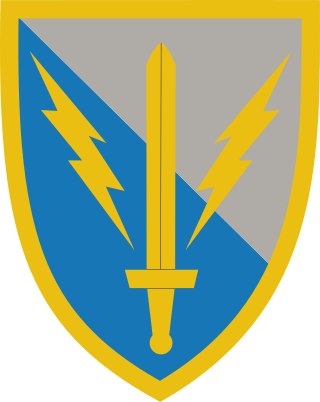
The 201st Expeditionary Military Intelligence Brigade is located at Joint Base Lewis-McChord, Washington. The 201st was originally named the 201st Military Intelligence Brigade and on 3 July 2008 it became the Army's third active duty battlefield surveillance brigade and was renamed the 201st Battlefield Surveillance Brigade (BfSB). The US Army decided to get rid of its BfSBs and the 201st was realigned into a new expeditionary military intelligence brigade.
The Reconnaissance & Surveillance Squadron is a specialized unit within the US Army's Battlefield Surveillance Brigade (BfSB) that blends ground Cavalry troops with an elite Long Range Surveillance (LRS) Airborne Infantry Company continuing the US Army's march toward a modular force.
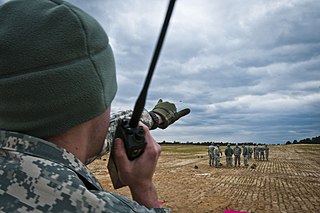
The United States Army Pathfinder Course trains military personnel in the U.S. Army and its sister services to set up parachute drop zones and helicopter landing zones for airborne and air assault missions.

The 219th Battlefield Surveillance Brigade was part of the United States Army Surveillance/reconnaissance formation introduced from c.2006-2011. The United States Army planned for the creation and transformation of nine intelligence brigades to a 'Battlefield Surveillance' role in 2007. The first Battlefield Surveillance Brigade (BfSB) was deployed the same year conducting Surveillance, Reconnaissance and Intelligence operations. However, gathering information is only half the challenge it faced. Along with the structural changes and intelligence capabilities, the sustainment capabilities of the brigade also changed.[2] The United States Army reorganized it’s intelligence formations into Battlefield Surveillance Brigades (BfSB). The brigades were self-sufficient Army Modular Forces. Army doctrine changed the name of the BfSB to Reconnaissance and Surveillance Brigade in 2011. In 2016, the 219th BfSB was redesignated to the 219th Engineer Brigade.
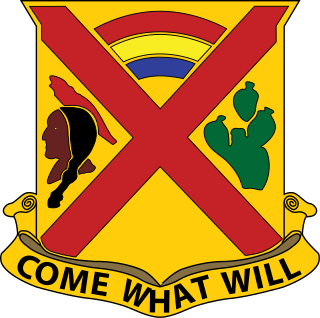
The 3rd Squadron (R&S), 108th Cavalry Regiment was the reconnaissance and surveillance element of the 560th Battlefield Surveillance Brigade of the Georgia Army National Guard. The squadron was headquartered in Atlanta, Georgia. Nicknamed Renegades, it consisted of:
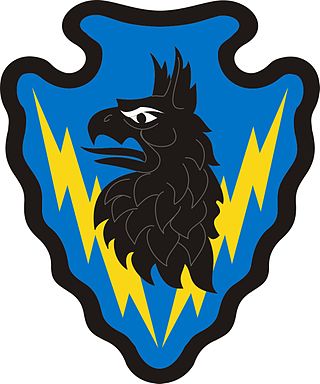
The 71st Expeditionary Military Intelligence Brigade (EMIB) is a unit of the Texas Army National Guard.

The 525th Expeditionary Military Intelligence Brigade (Expeditionary) is a unit of the United States Army specializing in the acquisition and analysis of information with potential military value. On 28 October 2014, the unit was reflagged from the "525th Battlefield Surveillance Brigade" to an expeditionary military intelligence brigade, the first of its kind.
The 71st Airborne Brigade was an airborne brigade of the United States Army and the Texas Army National Guard. The brigade was active from 15 January 1968 until 1 November 1973.

The 36th Airborne Brigade was an airborne brigade of the United States Army and the Texas Army National Guard. The brigade was active from 1 November 1973 to 1 April 1980. The unit's lineage continues today in the 36th Infantry Division.















